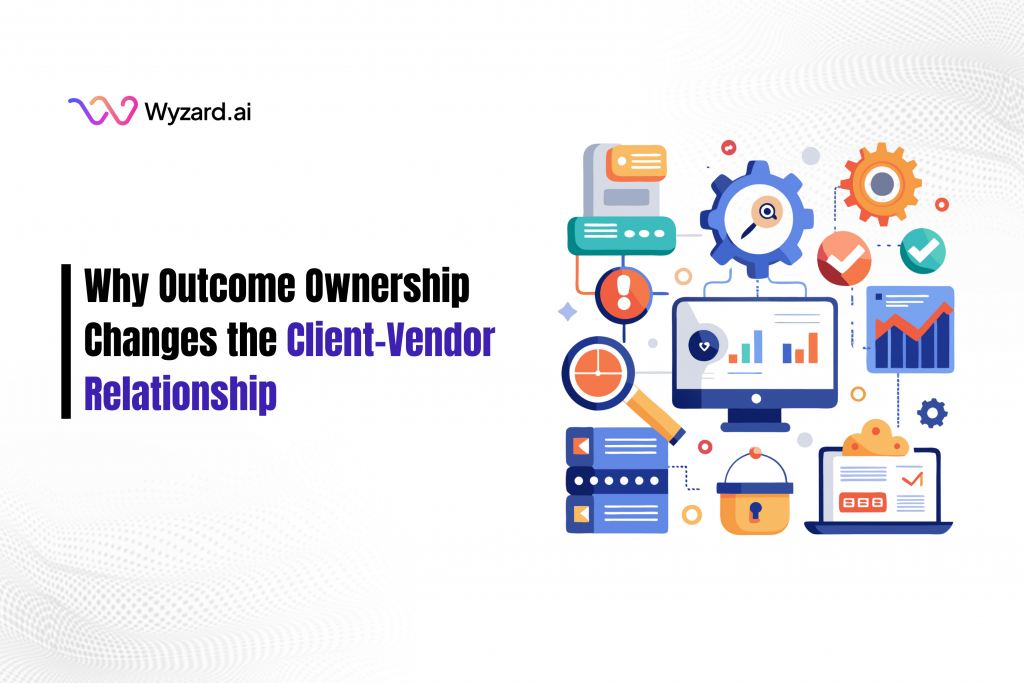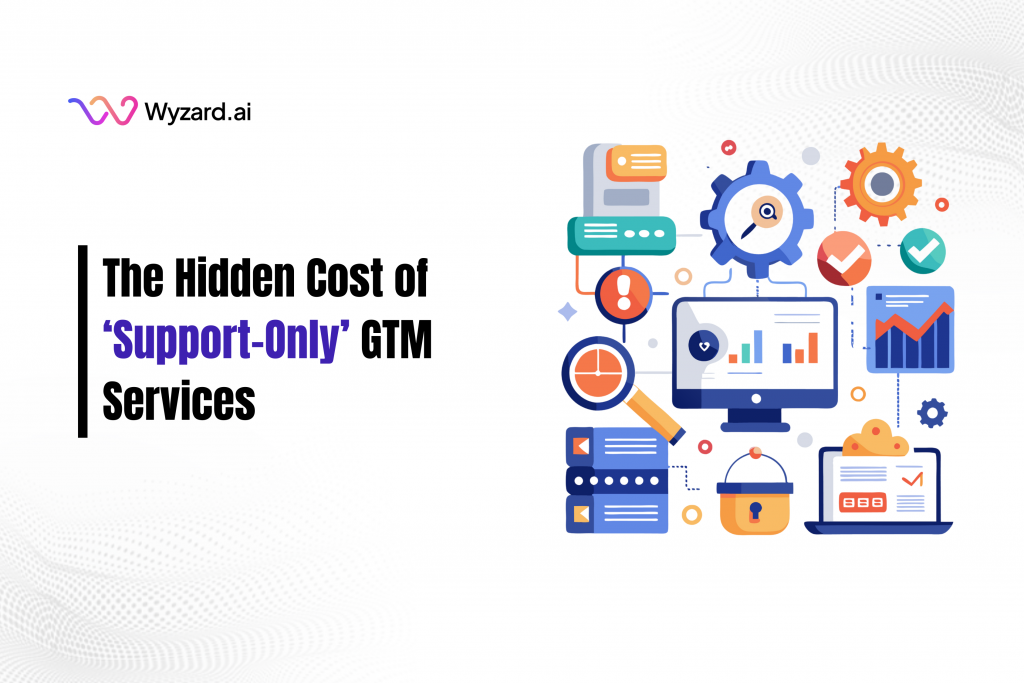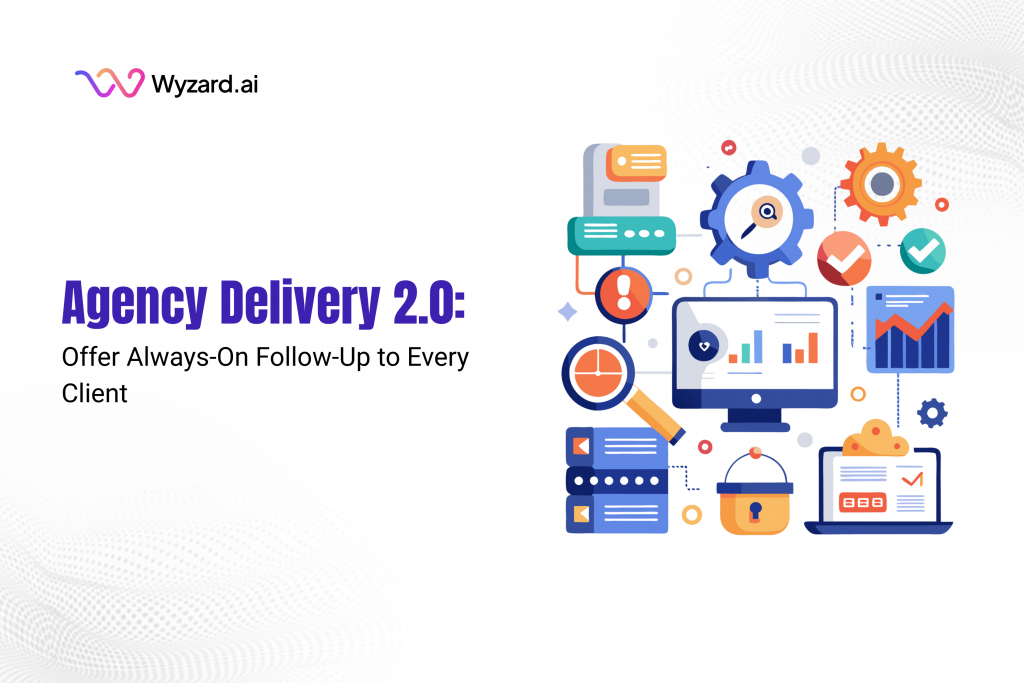A CMO signs a new GTM contract with high expectations. The tools look strong. The roadmap feels solid. The ...
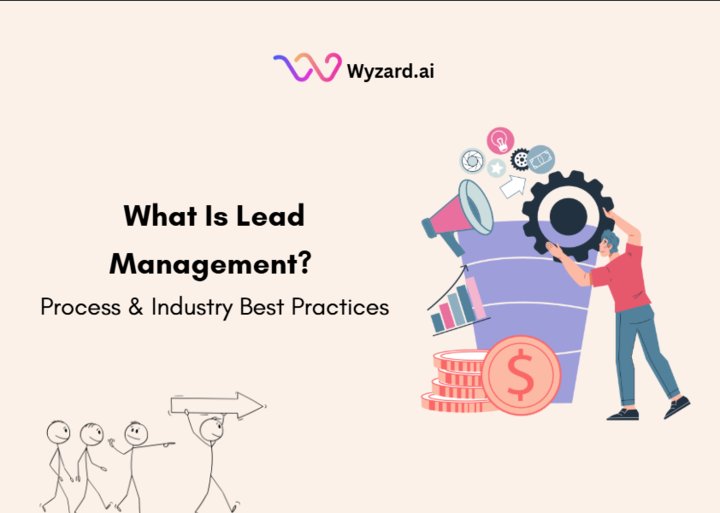
Subscribe Now
In today’s competitive environment, understanding and refining your lead management approach is critical for success. An effective lead management strategy covers everything from identifying potential customers to ultimately converting them into valuable clients. At its core, lead management involves managing the vital steps that transform web traffic and inbound interest into meaningful business opportunities.
The following sections outline the essential components of lead management, discussing in detail its process, tools, and best practices to ensure that every marketing effort translates into reliable results.
What is Lead Management? A Full Overview
Understanding the fundamentals of lead management is the first step toward developing effective strategies. What is lead management? It is a comprehensive framework that involves identifying, tracking, nurturing, and converting potential customers into loyal buyers. The goal is to ensure every interaction counts by guiding leads systematically through the sales funnel.
At its foundation, lead management focuses on turning initial interest into a data-driven asset. In practice, it means capturing high-intent leads, often through inbound channels such as website visits, event interactions, and email inquiries, and then qualifying, nurturing, and eventually converting them using a series of structured steps. The process emphasizes integrated strategies that bring together marketing content and sales follow-ups, ensuring that each prospect receives a tailored experience.
Modern lead management relies on advanced tools and automation. For example, AI-powered systems can track user behavior in real time, capture valuable insights, and engage prospects at critical moments. Learn more about how an intelligent solution can transform lead management by exploring Wyzard.ai.
In summary, lead management involves an organized sequence of activities designed to maximize conversion rates. Its proper implementation is essential for maintaining pipeline efficiency and driving revenue growth without increasing headcount.
The Lead Management Process: A Step-by-Step Guide
A well-structured lead management process is vital for transforming raw prospects into loyal customers. This systematic approach unfolds through several key stages, each of which plays a strategic role in nurturing leads and moving them closer to conversion.
- Lead Generation: The journey begins with attracting potential customers through various inbound channels such as content marketing, social media, and digital events. Companies focus on capturing interest from website visitors and those responding to email campaigns.
- Lead Qualification: Not every lead has the same potential. Robust qualification criteria help identify which prospects are most likely to convert. Establishing clear parameters improves the quality of leads passed to sales teams.
- Lead Nurturing: Once captured, leads benefit from personalized sequences, email nurturing, informative content, and interactive touchpoints that keep them engaged and interested. Timely follow-ups and customized messaging are crucial during this stage.
- Lead Scoring: Assigning numerical values to leads based on engagement and fit allows businesses to prioritize efforts. High-scoring leads receive more direct, immediate attention, ensuring that resources are focused on the most promising opportunities.
- Lead Distribution: Distributing qualified leads to the appropriate sales representatives ensures that prospects receive the attention they need. Automated routing systems help minimize delays and avoid manual errors in this handover process.
- Lead Conversion: The final step involves converting the nurtured, scored lead into a paying customer. Efficient sales cycles paired with responsive follow-up help seal the deal.
- Lead Tracking: Continuous monitoring of lead progress provides insights that can refine every stage of the process. Reliable metrics and feedback loops support ongoing improvements.
Applying an effective lead management process enhances overall marketing efficiency by ensuring that high-intent leads are identified and guided through each step of the funnel. For more detailed insights into optimizing response times, explore the discussion on Lead Response Time.
Key Lead Management Tools: Selecting the Best Options for Your Business
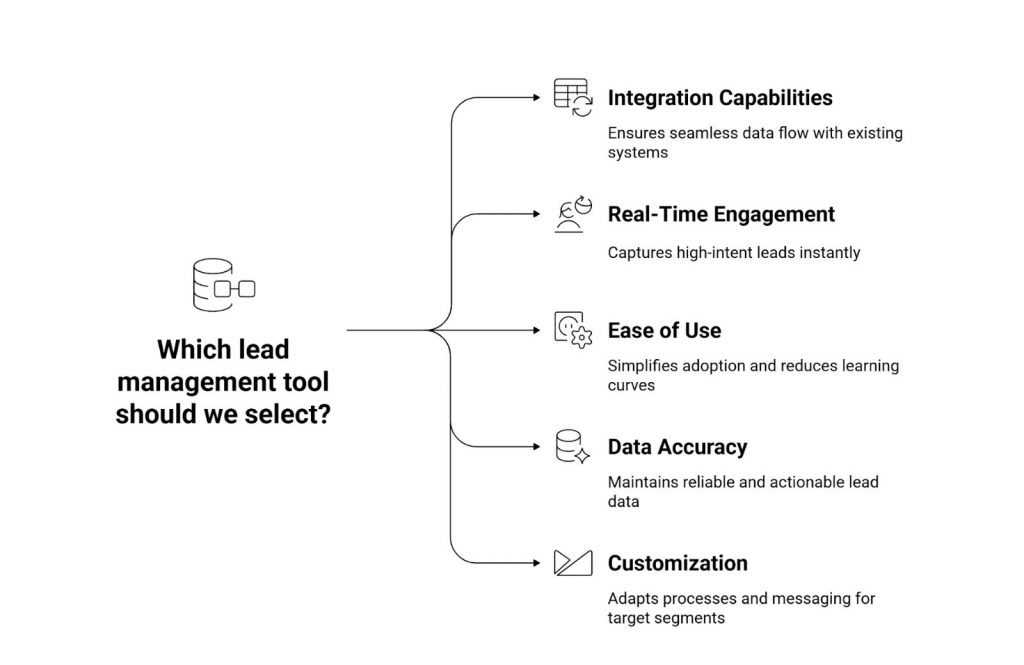
Choosing the right lead management tools can make a significant difference in converting interest into revenue. Modern tools combine data collection, behavioral tracking, and automated engagement to support a complete marketing strategy that resonates with prospects.
When selecting lead management tools, consider the following aspects:
- Integration Capabilities: The optimal tool works seamlessly with your existing CRM, marketing automation platforms, and email systems. Integration ensures a unified approach where data flow between systems remains uninterrupted.
- Real-Time Engagement: Tools that provide real-time interactions are essential to capture high-intent leads at the moment of interest. For instance, an AI-driven solution can initiate meaningful conversations on your website, addressing visitor queries and encouraging deeper engagement.
Wyzard.ai Agentic Inmail demonstrates how personalized responses can transform lead interactions into productive conversations.
Wyzard.ai’s Agentic InMail feature automates personalized responses to LinkedIn InMail messages from interested prospects. When potential buyers reach out through LinkedIn, the AI agent instantly crafts contextual replies based on the prospect’s profile, message content, and engagement history. This ensures that every LinkedIn conversation, whether it’s a demo request, pricing inquiry, or product question, receives an immediate, relevant response that moves the lead forward in their buying journey. By eliminating response delays on this critical professional channel, Wyzard.ai helps capture high-intent LinkedIn leads at their peak moment of interest. - Ease of Use: A user-friendly interface that supports quick setups and intuitive dashboards ensures that marketing teams can adopt the tool without steep learning curves. Tools should simplify processes, not complicate them.
- Data Accuracy: Clean, reliable data is at the heart of any effective lead management system. Tools with strong data validation features ensure that your lead database remains accurate and actionable.
- Customization: The ability to adapt processes and messaging to different target segments enhances the overall effectiveness of lead management. Tools that allow for personalization help create campaigns that speak directly to prospects needs.
These considerations result in a well-tuned, responsive system that can adapt to the rapid pace of inbound lead engagement. The right lead management tool empowers companies to automate repetitive tasks, allowing teams to concentrate on strategic decision-making and relationship building.
For SaaS marketers who need to ensure that every lead receives immediate, tailored follow-up, selecting appropriate tools becomes an integral part of a broader lead management strategy.
Optimizing Lead Management Systems: Essential Components for Success
Creating robust lead management systems calls for a focus on automation, reliable integration, and continuous performance tracking. A system designed to manage high volumes of inbound leads must incorporate intelligent automation and smooth coordination between marketing and sales workflows.
Key components of an efficient lead management system include:
- Automated Workflows: Systems with automated workflows reduce reliance on manual processes. Automation helps in qualifying leads, triggering communications, and scoring prospects based on predefined criteria.
- Seamless Integration: Integration with CRM solutions, marketing automation platforms, and other sales tools creates a cohesive environment where data moves freely between systems. This connectivity is crucial in maintaining data quality and ensuring that every relevant interaction is recorded.
Visit Wyzard.ai to see how a plug-and-play integration can simplify your processes. - Intelligent AI Engagement: Modern systems incorporate AI to understand behavioral signals and perform context-based interactions. An intelligent system can analyze buyer signals and tailor responses accordingly.
- Real-Time Analytics: A robust system continuously monitors lead behavior and tracks performance metrics. Real-time analytics enable a dynamic approach, allowing teams to adjust strategies as needed quickly. Insights from analytics also support long-term strategic decisions regarding process improvements.
- User-Friendly Dashboards: To effectively manage complex lead processes, administrators require dashboards that provide clear overviews of funnel activity. Accessible displays with key performance indicators (KPIs) assist teams in pinpointing bottlenecks and opportunities for refinement.
When a lead management system incorporates these elements, it not only streamlines operations but also drastically improves the quality of lead interactions. A well-integrated system acts as the central nervous system for all marketing efforts, ensuring that every qualified lead is nurtured and guided appropriately down the funnel.
SaaS marketers who deploy smart systems may observe increased conversion rates and reduced friction between marketing and sales teams, a reflection of how technology-driven strategies can drive tangible outcomes.
B2B Lead Management Solutions: Best Practices for SaaS Marketers
For companies operating in the B2B SaaS space, adopting specialized b2b lead management solutions is essential for addressing unique challenges in the sales process. B2B addresses more complex buying cycles that often involve multiple stakeholders and require detailed, relationship-driven interactions. Implementing targeted lead management solutions can greatly impact conversion rates and overall pipeline velocity.
Key best practices for B2B lead management include:
- Aligning Marketing and Sales: Clear alignment between marketing and sales teams is crucial. Coordinated efforts ensure that leads are not only generated but are also effectively qualified so that sales teams can focus on high-potential prospects. An integrated approach minimizes miscommunication and speeds up the transition from lead to customer.
- Personalized Outreach: Personalization serves as a competitive advantage in penetrating complex decision-making units. Campaigns designed to address the specific pain points and needs of potential buyers demonstrate an understanding of the prospect’s business challenges and foster trust.
- Real-Time Engagement: Immediate interactions are vital in keeping the lead engaged. Instant messaging and contextual follow-ups ensure that high-intent leads do not slip away because of delayed responses. Strategies that combine automated workflows with intelligent agents often create a seamless customer experience.
- Data-Driven Insights: Continuous monitoring of lead behavior and engagement provides valuable data that can inform future campaigns. Detailed analytics help refine qualification criteria and identify successful tactics, a practice supported by rigorous research methodologies.
- Multi-Channel Coordination: B2B lead management solutions require a multi-channel approach, ensuring every engagement point, from website visits to email inquiries, is consistently addressed. Coordinated campaigns across various channels maximize exposure and reinforce the brand message.
Adopting these best practices creates a robust framework that transforms high-intent leads into loyal customers. A dedicated system using proven strategies ensures that every touchpoint is optimized for conversion, ultimately boosting pipeline efficiency without scaling headcount.
Mastering the Lead Management Process Flow: Strategies and Considerations
An organized lead management process flow is central to ensuring that prospects move smoothly from the initial point of contact to becoming a paying customer. Optimizing each stage requires clear strategies and careful planning to avoid pitfalls that can result in lost opportunities.
Strategies for an effective process flow include:
- Prioritization of Leads: Establish criteria that identify promising prospects through detailed scoring models. By categorizing leads based on engagement metrics and behavioral signals, marketing teams can minimize wasted efforts. Superior lead management results from a precise allocation of resources to the highest value leads.
- Timeliness in Follow-Ups: Delays in communication can hamper conversion efforts. Studies indicate that quick responses lead to better outcomes in converting high-intent leads. Emphasis on swift, personalized follow-ups helps retain prospect interest. For additional guidance on optimal response times and strategies, refer to the article on Lead Response Time.
- Automation in Process Flow: Automating repetitive tasks within the lead management process flow minimizes potential errors and reduces workload. Automated routing and qualification frameworks can ensure a consistent, timely progression through each stage, freeing up valuable time for strategic planning.
- Continuous Monitoring and Improvement: Regularly evaluate process performance using predefined KPIs. By tracking conversion rates at each stage, teams can identify bottlenecks and implement targeted improvements. The feedback loop is essential in maintaining an adaptive and responsive process.
- Customization and Flexibility: Tailor your process flow to reflect target audience behaviors and specific industry challenges. In a highly competitive environment, maintaining a flexible process flow ensures that updates and improvements are implemented swiftly, providing a consistent and personable experience.
An effective process flow not only increases conversion rates but also strengthens customer relationships by ensuring that every lead is treated with care and precision. An optimized approach helps mitigate common challenges—such as lead leakages- and reinforces the value of each engagement.
Industry Best Practices in Lead Management: Actionable Tips
Implementing industry best practices in lead management can significantly improve overall performance. Well-defined, actionable tips from research-backed methodologies and industry guidelines can help refine your strategy and optimize conversion rates.
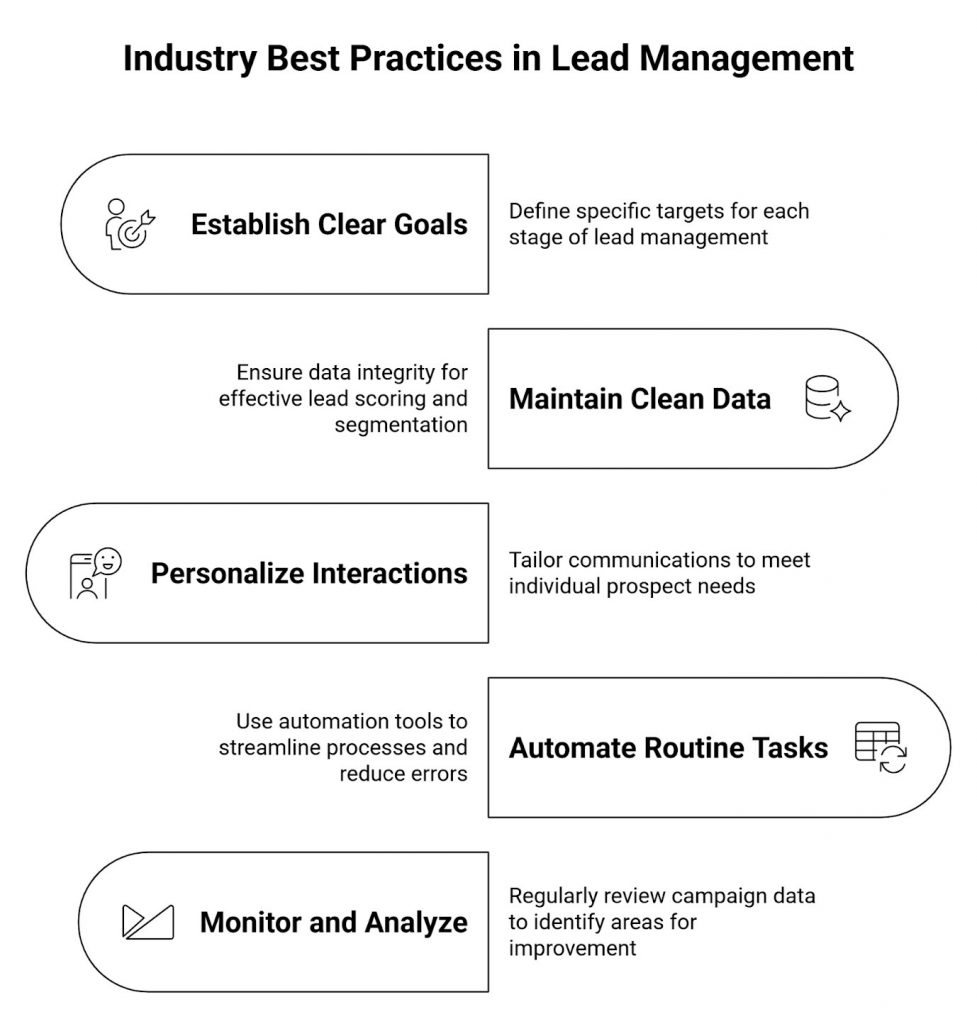
Some Actionable Tips Include:
- Establish Clear, Measurable Goals: Define specific targets for each stage of the lead management process. Goals based on measurable outcomes ensure that marketing teams can assess success and adapt strategies accordingly. Setting benchmarks for lead response times, conversion ratios, and engagement rates allows for continuous performance improvements.
- Maintain Clean, First-Party Data: Reliable data is the foundation of any effective lead management strategy. Data integrity must be a priority; accurate records ensure that lead scoring and segmentation produce meaningful results.
- Personalize Every Interaction: Prospects respond positively when communications address their unique needs. Personalized messages, tailored content, and customized follow-ups demonstrate attentiveness and help build trust over time. Automated systems that adapt their messaging based on real-time signals can significantly reduce friction in the conversion process.
- Automate Routine Tasks: Incorporate automation at every opportunity to remove manual processes that can slow down follow-ups or introduce errors. Automation tools within a lead management system handle tasks such as email outreach, lead assignment, and reminder notifications automatically.
- Monitor, Analyze, and Refine Processes: Regular review of campaign data and process performance helps uncover areas needing improvement. Detailed analytics and periodic audits support informed adjustments, setting the stage for a dynamic and ever-improving lead management strategy.
Adhering to these best practices results in a more refined and effective lead management system, one that not only boosts conversion rates but also ensures that every prospect receives targeted, meaningful communication. For additional insights on stopping lead leakage and retaining website visitors, explore the analysis on Why 98 Percent Website Visitors Leave.
Conclusion
In summary, effective lead management is the cornerstone of a thriving revenue engine. A comprehensive strategy involves defining what lead management is, mapping out a detailed lead management process, employing the right tools and systems, and implementing best practices that ensure every lead is nurtured and converted with precision.
By adopting an organized process flow, utilizing advanced lead management tools, and following industry-tested best practices, SaaS marketers can significantly improve pipeline efficiency and foster higher conversion rates—all without increasing headcount. AI GTM Orchestration platforms like Wyzard.ai offer a solution designed specifically for software companies seeking to automate their engagement and qualify leads in real time.
For teams aiming to reduce sales friction and embrace intelligent, automated processes, exploring modern lead management solutions is a vital step forward. Discover how real-time AI-driven interactions and integrated tools can transform your inbound marketing strategy by visiting Wyzard.ai.
Adopt a strategic approach to lead management, and watch your business grow as high-intent leads find their way through an optimized sales funnel. Get started with Wyzard.ai today and experience the difference in intelligent interactions that convert.
Frequently Asked Questions
Lead management focuses specifically on capturing, nurturing, and qualifying potential customers before they enter the sales pipeline. A CRM (Customer Relationship Management) system is broader, managing the entire customer lifecycle, including post-sale relationships. While lead management systems concentrate on converting prospects into sales-ready opportunities, CRMs track all customer interactions from first contact through ongoing support. Many businesses use lead management tools that integrate with their CRM for a complete solution.
The lead management process timeline varies significantly based on industry and product complexity. For B2B SaaS companies, the average process spans 3-6 months from initial contact to conversion. Simple products with lower price points might convert leads within days or weeks, while enterprise solutions can take 12-18 months. The key is maintaining consistent engagement throughout the journey with automated nurturing campaigns and timely follow-ups at each stage.
Essential lead management software features include automated lead scoring, real-time engagement capabilities, CRM integration, and behavioral tracking. Look for tools that offer customizable workflows, multi-channel communication (email, chat, web), and detailed analytics dashboards. Advanced features like AI-powered qualification, prospect enrichment without forms, and intelligent routing to sales teams can significantly improve conversion rates and reduce manual work.
Success in lead management is measured through key metrics, including conversion rate (leads to customers), lead velocity (time from capture to conversion), and lead quality scores. Track your cost per lead, lead-to-opportunity ratio, and sales-qualified lead (SQL) acceptance rate. Monitor engagement metrics like email open rates, content downloads, and website return visits. Most importantly, measure revenue attribution to understand which lead sources and nurturing tactics drive the most value.
The biggest mistake in B2B lead management is poor alignment between marketing and sales teams, resulting in qualified leads falling through the cracks. Companies often fail to establish clear handoff criteria, leading to delays in follow-up when leads are at peak interest. Other common errors include treating all leads equally without proper scoring, relying on manual processes that create bottlenecks, and neglecting to nurture leads who aren’t immediately sales-ready.
Small businesses can significantly benefit from lead management systems, especially cloud-based solutions that don’t require large upfront investments. These systems help small teams work more efficiently by automating repetitive tasks like lead scoring, email follow-ups, and data entry. For resource-constrained businesses, lead management tools ensure no potential customer is forgotten and help maintain professional, timely communication that competes with larger competitors. Many solutions offer scalable pricing that grows with your business.
Other blogs
The latest industry news, interviews, technologies, and resources.
The Hidden Cost of GTM Execution: Why GTM execution gaps Stall Revenue
A CMO approves a GTM initiative that looks solid on paper. The tools are live. The workflows exist. Support ...

Agency Delivery 2.0: Offer Always-On Follow-Up to Every Client
Most agencies are great at launching campaigns. The kickoff is sharp, the messaging is solid, and early results look ...

 We’ve secured funding to power Signal-to-Revenue AI to GTM teams globally. →
We’ve secured funding to power Signal-to-Revenue AI to GTM teams globally. →